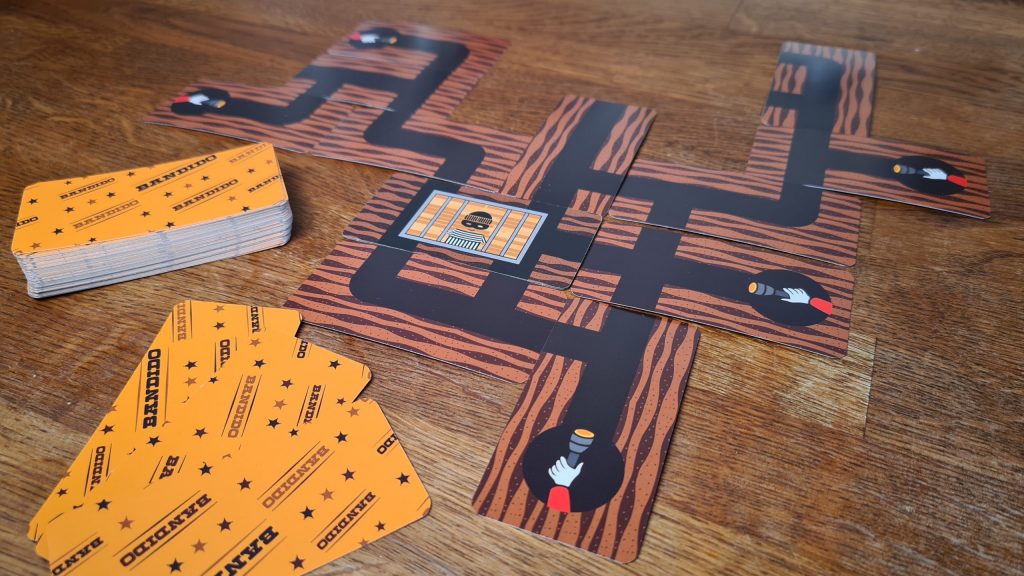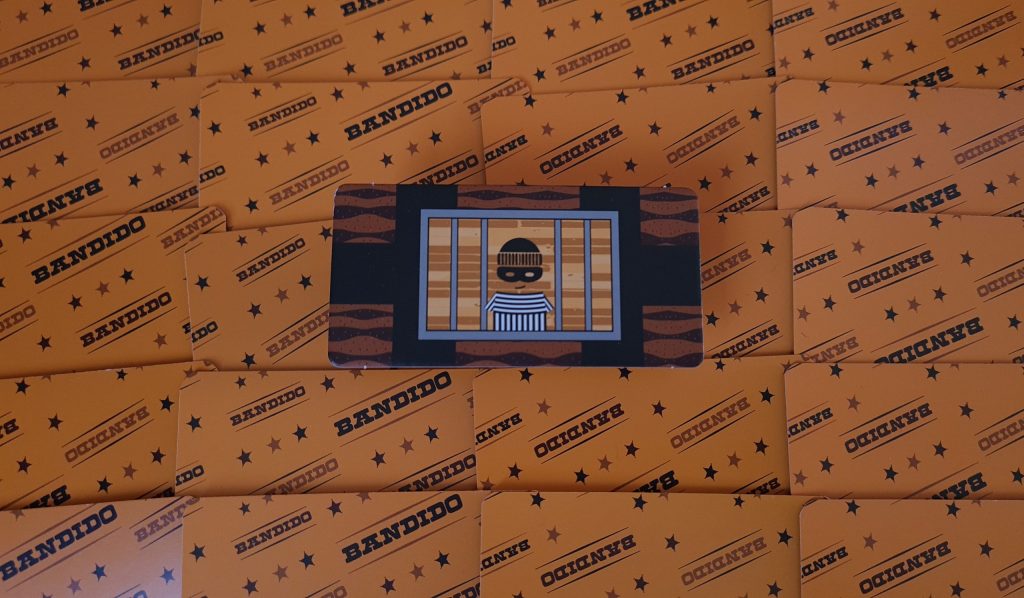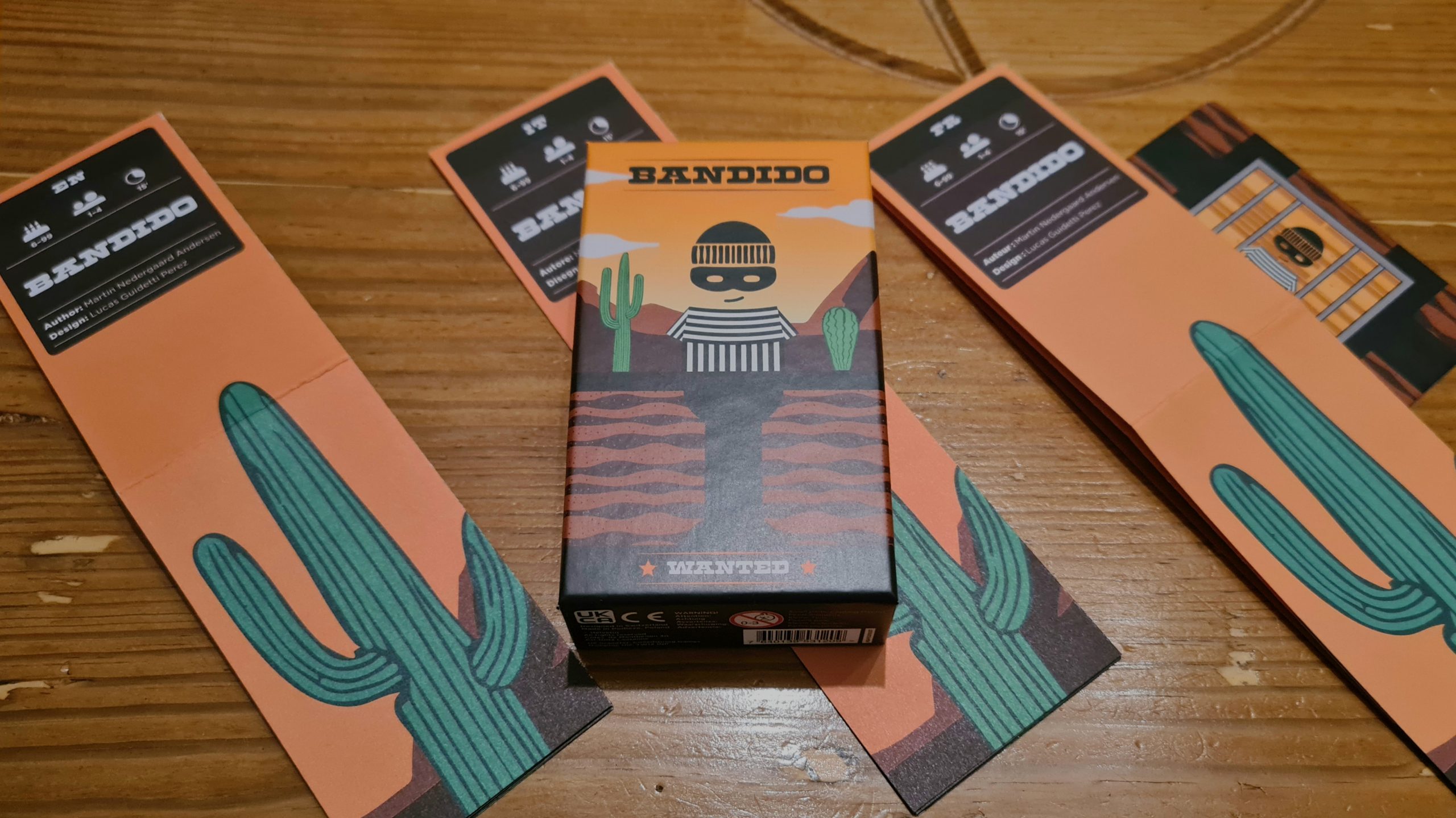Bandido is a card based cooperative route building game, published originally in 2016 by Helvetiq. Designed by Martin Nedergaard Andersen, the game sees 1 – 4 players trying to stop a prisoner from escaping via tunnels below his jail cell. Playing in under 15 minutes, cards will be placed, snaking tunnels formed and hopefully Bandido will be caught! However, is this a game that should capture your attention or should you let it escape? Let’s find out!
Bandido is ready to go straight out of the box, with the jail cell special tile placed in the middle of the table. The cards can be shuffled, with each player drawing a hand of 3 cards. After randomly determining a starting player, the game can begin. Each turn the active player chooses one card from their hand and adds it to an ever growing map of tunnels. Cards can be played in any orientation. However, when placing a card all previous tunnel paths must be taken into account. If a card doesn’t fit, with previous paths cut off by card edges, then it cannot be played – at least to that location.
Once a player has played a card they redraw back up to a hand of 3 cards from the deck, with play then moving clockwise to the next player. The aim of Bandido is to block all of the tunnels before the deck runs out. This is achieved in two ways. Some of the tunnel cards feature routes leading to flashlights – which serve to block that tunnel path. The other way is to place the cards in such a way that two or more tunnel routes link up, causing them both to lead back to the jail cell. The twist is that, while players can generally discuss what to do, it is forbidden to reveal what cards they have in their hand. Either way the players win or lose together as a team, so everyone must work together to capture Bandido!

Games can be over in a few turns, if the right doubling back tunnel paths or flashlight blocked route cards are drawn. At the other end of the scale, games can reach around 15 minutes with a sprawling mess of tunnels exploding out from the jail cell. Not every playthrough captures the tension that you want from a puzzle. Thankfully, these are edge cases. For the majority of the time it feels fully achievable, whilst the challenge makes it so there is a sense of satisfaction from finally capturing Bandido. As the tunnels start to spawl even closing off a few of the routes feels like a small win to capitalise on towards victory!
A bit like in other tile placement style games, players can spot where future cards could be placed. Similar to the roads in Carcassonne, players will know some of the tunnel paths that could come out of the deck. You can try to leave spaces for those exact cards – though the game doesn’t always allow players the luxury of waiting. Just when you have narrowed down the tunnels, combining a couple into one route, the next player might have no other option than to split it out again, or put a card in the space you’ve been waiting to fill. Therefore, regardless of if players know a card could be perfect in a spot often it isn’t worth waiting for, and thus the challenge of the puzzle is maintained.
Part of the Bandido puzzle is not knowing what options the other players have from the cards in their hand. Leaving others a number of good options of where to go can be key to success. Despite this, playing solo is an interesting puzzle. Even with 100% information as a solo player you are limited by only having access to 3 cards at a time. Therefore as one limit is lifted another one takes its place. Combine this with the speed of setup/teardown and Bandido is one of the few games that is a pleasure to play solo – as it isn’t a load of effort to go through just for yourself.

Coming in a small box Bandido seems like it should be a perfect travel or on the go style game. While the size gives the game portability, it demands a lot of table space to be played. As the deck starts to dwindle the tunnel system can be anything but small. Therefore, this isn’t a game that could be played on a small coffee table or in most hotel rooms easily. The cards that build out the tunnels are slightly on the small size but aren’t ever fiddly to place or hold. Fortunately, enough space is afforded so that the tunnel paths are always very legible – which is needed as it extends across the table.
For the size of the box Bandido manages to squeeze in an entertaining puzzle that can dominate a table. The way the game explodes in all directions does mean what looks like an ideal travel game might not be for some, though if your destination has a standard table it isn’t an issue. Bandido won’t be caught every time but how close players can get whilst losing only makes it harder not to play multiple games in a row. Some will love this as a solo puzzle, with others enjoying the slight lack of information available when other players are involved. Either way merely attempting to catch Bandido is a fast and fun experience more people should try!
(Editor’s Note: Bandido was provided to us by Coiledspring Games for the review. The game is currently available from local board game stores! Find your local store here.)

